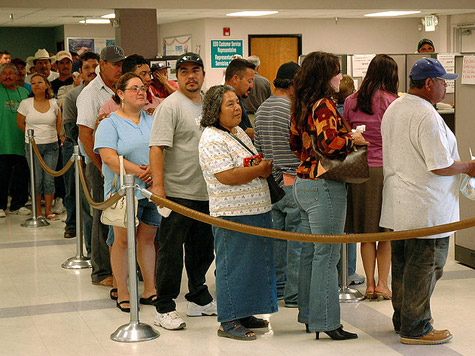
The media is high-fiving itself over the July Jobs Report’s headline number that 163,000 jobs were created in July. This simply tells us that economics is not a prerequisite for a journalism degree. Obviously, its good news if there is a net-gain in jobs in a given month, but we shouldn’t extrapolate too much from today’s headline number. In fact, there is lots of worrisome data in today’s report.
Let’s call today’s report a “Tale of Two Surveys.” In calculating the jobs report, the Labor Department conducts a survey of employers and a survey of households. The survey of employers gives us an estimate of the numerical number of jobs created or lost. The household survey gives us the unemployment rate. Because of quirky “seasonal adjustments” made to the employer survey, we have a report where we “added” 163,000 jobs, 150,000 people left the work-force (who are no longer counted in terms of the unemployment rate) and, yet, the unemployment rate went up to 8.3%, breaking records for the longest time unemployment in the U.S. has been over 8%.
This paradox is explained by the household survey, which showed that employment fell by 195,000 last month, the first decline in the survey in three months. This is important, because the household survey does a better job of capturing employment in small businesses and new start-ups. The Labor Department’s employer survey, which generates the net-payroll number, is based on large companies and government agencies. Expect a big down-ward revision in today’s headline number next month. June’s payroll number, after all, was revised down today a full 20%.
Even setting aside the conflicting signals from the different surveys and assuming the 163k headline number is real, this is still bad news overall. The economy needs to add over 200k jobs each month, just to keep pace with population growth. Until we reach that level, we won’t be able to add the jobs that were lost in the aftermath of the recession.
Worse, there is nothing in some of the other under-lying numbers to suggest a return to robust growth anytime soon. Hours worked per week, 34.5, were unchanged from last month. Overtime was also flat. This is important because employers will generally increase the hours of existing employees before they add to their payrolls. That they aren’t suggests that their current workforce is adequate to meet current economic demands.
Hourly earnings were also flat, rising just 2 cents. Adjusting for even the relatively low inflation indicates that real earnings fell this month, a very bearish sign for future consumer spending.
Today’s report confirms what many of us have known; the economy is stalled. Perhaps it isn’t declining, but there is very little growth to be seen anywhere. But, our economy needs growth to even stay even. If growth continues to be as elusive as today’s jobs report suggests, the actual decline is just a matter of time.

COMMENTS
Please let us know if you're having issues with commenting.